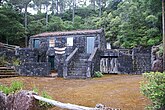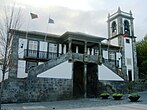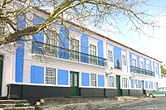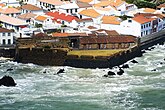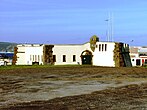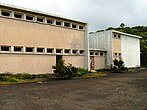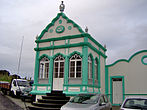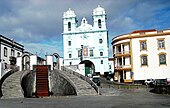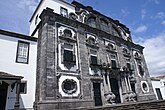-
An example of the local farm-style home in the Forest Park of Prainha, São Roque do Pico
-
The historic Paços do Concelho (municipal palace) of the municipality of Praia da Vitória
-
The palatial estate house of Madre de Deus, in the historic centre of Sé
-
The Regional Legislative Assembly building of the Azores, located in the town of Horta
The Heritage sites of the Azores, a sub-section of the Portuguese National Monuments, date back to the early discovery and settlement of the islands of the Azores. Through successive historical events the archipelago of the Azores, has witnessed several phases of construction associated with defensive structures, homes and places of worship to suit their requirements and means. The formal organization of the Portuguese state resulted in a process to qualify and quantify those structures that have had an intrinsic value to the Portuguese culture.
Starting with the Direcção Geral dos Edifícios e Monumentos Nacionais (DGMEN), and later by the Instituto de Gestão do Património Arquitectónico e Arqueológico (IGESPAR), the Portuguese government developed a registry of national monuments that includes a rich heritage of historical patrimony throughout the country. Following the implementation of a Autonomy Statute (which was also implemented in Madeira), the designation and protection of regional patrimony was transferred to the responsibility of the Secretaria de Cultura (Secretariate for Cultura).
This is a compilation of those structures that are designated as National Monuments ( Portuguese: Monumentos Nacionais) or Property of Public Interest ( Portuguese: Imóveis de Interesse Público), of a regional nature.
History
With the rise of the Portuguese state after the beginning of the Age of Discovery, Portuguese architecture expanded under the patronage of the wealthy kings, nobility, powerful clergy and through the many battles with rivals such as Castile, the French and Dutch. The settlement and growth of Portuguese settlements in the Azores, by mainly poor rural settlers and second-tier nobility resulted in a simple patrimony consisting of small bungalow-like homes, two-storey dwellings with mixed house-and-barn or semi-palatial houses and manors. In addition, the administrative and religious functions constructed semi-ornate structures to govern their political or spiritual functions, resulting in grande palaces, municipal halls, impérios, convents and churches, while along many of the settlements of these islands, there were wayside shrines, crosses and pillories. Although many of the prominent buildings were destroyed, rebuilt, re-purposed and closed on the whims of the monarchy, the islands were also affected by natural calamities that spared little of the original structures.
Monuments
While the Instituto de Gestão do Património Arquitectónico e Arqueológico (IGESPAR) (Institute for the Management of Architectural and Archaeological Heritage), has been responsible for classifying and promoting the restoration of these national treasures, with the autonomy of the islands of Madeira and the Azores in 1975, these responsibilities have been transferred to the regional authority, and in particular the Direcção Regional de Cultura (General-Directorate for Culture).
Owing to its relative value and importance, the cultural property may be listed as or national, public or municipal interest. [1] In addition, these definitions are also defined in terms of being monuments, groups of buildings or sites, based on existing international conventions. IGESPAR regularly proposes the listing of new assets based on its mission to safeguard national heritage. As time goes by, a wide variety of new buildings and groups of structures of varying typologies have been added to the national register of monuments, such modernist architecture, vernacular landscapes, archaeological sites, monastic buildings/structures, historical gardens, and more recently human-built business and industrial establishments. [1]
The listing process follows a strict procedure defined by Decree-Law no. 309/2009 (23 October 2009), which entered into force in January 2010. [1]
IGESPAR also monitors and participates in the UNESCO registry of World Heritage Sites as a member state: there are 13 UNESCO World Heritage Sites in territory of Portugal. [2] Similarly, eleven assets in the UNESCO world heritage list of 878 sites were former Portuguese possessions at one time, spread across three continents (Africa, America and Asia) associated with period of Portuguese Discoveries. [3]
In the following list patrimony preceded by an Azorean flag, are considered property, landmarks or monuments with patrimonial interest in the Azores:
Civic
- Corvo
- Building of Correios, Telégrafos e Telefones (CTT) de Corvo ( Corvo, Vila do Corvo)
- Building of the Repartições Públicas do Corvo ( Corvo, Vila do Corvo)
- Casa de Despejos Canada do Maurício ( Corvo, Vila do Corvo)
-
 Cova de Junça (
Corvo,
Vila do Corvo)
Cova de Junça (
Corvo,
Vila do Corvo) -
 Eira Avenida Nova (
Corvo,
Vila do Corvo)
Eira Avenida Nova (
Corvo,
Vila do Corvo) -
 Eira Canada do Maurício (
Corvo,
Vila do Corvo)
Eira Canada do Maurício (
Corvo,
Vila do Corvo) -
 Eira Rua da Matriz (
Corvo,
Vila do Corvo)
Eira Rua da Matriz (
Corvo,
Vila do Corvo) -
 Fountain Rua da Fonte (
Corvo,
Vila do Corvo)
Fountain Rua da Fonte (
Corvo,
Vila do Corvo) -
 Ladeira do Maranhão (
Corvo,
Vila do Corvo)
Ladeira do Maranhão (
Corvo,
Vila do Corvo) - Lighthouse of Ponta Negra ( Corvo, Vila do Corvo)
-
 Residence Caminho da Galinha (
Corvo,
Vila do Corvo)
Residence Caminho da Galinha (
Corvo,
Vila do Corvo) -
 Residence Canada do Maurício (
Corvo,
Vila do Corvo)
Residence Canada do Maurício (
Corvo,
Vila do Corvo) -
 Residence Canto do Porto da Casa (
Corvo,
Vila do Corvo)
Residence Canto do Porto da Casa (
Corvo,
Vila do Corvo) -
 Residence Rua da Cruz (
Corvo,
Vila do Corvo)
Residence Rua da Cruz (
Corvo,
Vila do Corvo) -
 Residence Rua da Matriz (
Corvo,
Vila do Corvo)
Residence Rua da Matriz (
Corvo,
Vila do Corvo) -
 Residence Rua do Porto da Casa (
Corvo,
Vila do Corvo)
Residence Rua do Porto da Casa (
Corvo,
Vila do Corvo) -
 Residence of Mariana Lopes (
Corvo,
Vila do Corvo)
Residence of Mariana Lopes (
Corvo,
Vila do Corvo) -
 Rural Residence Avenida Nova (
Corvo,
Vila do Corvo)
Rural Residence Avenida Nova (
Corvo,
Vila do Corvo) -
 Windmills Caminho dos Moinhos (
Corvo,
Vila do Corvo)
Windmills Caminho dos Moinhos (
Corvo,
Vila do Corvo) -
 Zimbral (
Corvo,
Vila do Corvo)
Zimbral (
Corvo,
Vila do Corvo)
- Faial
- Building of Correios, Telégrafos e Telefones (CTT) da Horta ( Matriz, Horta)
- Building of the Regional Legislative Assembly of the Azores ( Matriz, Horta)
- Building of the Sociedade Amor da Patria ( Matriz, Horta)
- Câmara Municipal da Horta ( Matriz, Horta)
- Casas das Arrumaçãos dos Cabos Submarinos ( Angústias, Horta)
- Centro de Assistência da Horta ( Conceição, Horta)
- Dabney Family Lookout ( Angústias, Horta)
- Faialense Theatre ( Matriz, Horta)
- Hospital of Horta ( Angústias, Horta)
- Lighthouse of Ponta dos Capelinhos ( Capelo, Horta)
- Lighthouse of Ribeirinha ( Ribeirinha, Horta)
- Old County Jail of Horta ( Angústias, Horta)
- Old Whaling Station of Porto Pim ( Angústias, Horta)
- Radio-Naval/Naval Radio-Telegraphic Station of Horta ( Angústias, Horta)
- Residence of the Dabney Family "The Cedars" ( Angústias, Horta)
- Secondary School Manuel Arriaga ( Conceição, Horta)
- Flores
-
 Barn Rua Padre José Luís de Fraga (
Fajã Grande,
Lajes das Flores)
Barn Rua Padre José Luís de Fraga (
Fajã Grande,
Lajes das Flores) -
 Barns Ramal da Fajã Grande (
Fajã Grande,
Lajes das Flores)
Barns Ramal da Fajã Grande (
Fajã Grande,
Lajes das Flores) -
 Barns Rua Enginheiro Pinelo (
Mosteiro,
Lajes das Flores)
Barns Rua Enginheiro Pinelo (
Mosteiro,
Lajes das Flores) - Building of Correios, Telégrafos e Telefones (CTT) de Santa Cruz das Flores ( Santa Cruz das Flores, Santa Cruz das Flores)
- Casa Pimental de Mesquita ( Santa Cruz das Flores, Santa Cruz das Flores)
-
 Cerradas (
Fajã Grande,
Lajes das Flores)
Cerradas (
Fajã Grande,
Lajes das Flores) -
 Cuada (
Fajã Grande,
Lajes das Flores)
Cuada (
Fajã Grande,
Lajes das Flores) - District Courthouse of Santa Cruz das Flores ( Santa Cruz das Flores, Santa Cruz das Flores)
-
 Fountain of Ponta da Fajã (
Fajã Grande,
Lajes das Flores)
Fountain of Ponta da Fajã (
Fajã Grande,
Lajes das Flores) - Lighthouse of Albernaz ( Ponta Delgada, Santa Cruz das Flores)
- Lighthouse of Ponta das Lajes ( Lajes das Flores, Lajes das Flores)
-
 Mills Ribeira das Casas (
Fajã Grande,
Lajes das Flores)
Mills Ribeira das Casas (
Fajã Grande,
Lajes das Flores) - Posto de Despacho de Santa Cruz das Flores ( Santa Cruz das Flores, Santa Cruz das Flores)
- Pousada das Lajes ( Lajes das Flores, Lajes das Flores)
- Radio-Naval/Naval Radio-Telegraphic Station of Flores ( Lajes das Flores, Lajes das Flores)
-
 Residence Rua da Assumada (
Fajã Grande,
Lajes das Flores)
Residence Rua da Assumada (
Fajã Grande,
Lajes das Flores) -
 Residence Rua de Baixo (
Fajã Grande,
Lajes das Flores)
Residence Rua de Baixo (
Fajã Grande,
Lajes das Flores) -
 Residence Rua da Direita (
Fajã Grande,
Lajes das Flores)
Residence Rua da Direita (
Fajã Grande,
Lajes das Flores) -
 Residence Rua da Fontinha (
Fajã Grande,
Lajes das Flores)
Residence Rua da Fontinha (
Fajã Grande,
Lajes das Flores) -
 Residence Rua Senador André de Freitas (
Fajã Grande,
Lajes das Flores)
Residence Rua Senador André de Freitas (
Fajã Grande,
Lajes das Flores) -
 Residence Vigia d'Água (
Fajã Grande,
Lajes das Flores)
Residence Vigia d'Água (
Fajã Grande,
Lajes das Flores) -
 Water mill Ribeira da Alagoa (
Fajã Grande,
Lajes das Flores)
Water mill Ribeira da Alagoa (
Fajã Grande,
Lajes das Flores)
- Graciosa
-
 Curraletas ao Barro Vermelho (
Santa Cruz,
Santa Cruz da Graciosa)
Curraletas ao Barro Vermelho (
Santa Cruz,
Santa Cruz da Graciosa) - Hospital of Santa Cruz da Graciosa ( Santa Cruz, Santa Cruz da Graciosa)
-
 Kindergarten of Guadalupe (
Guadalupe,
Santa Cruz da Graciosa)
Kindergarten of Guadalupe (
Guadalupe,
Santa Cruz da Graciosa) - Lighthouse of Carapacho ( Luz, Santa Cruz da Graciosa)
- Lighthouse of Ponta da Barca ( Santa Cruz, Santa Cruz da Graciosa)
- Posto de Despacho da Praia da Graciosa ( Praia, Santa Cruz da Graciosa)
-
 Primary School Caminho da Igreja (
Guadalupe,
Santa Cruz da Graciosa)
Primary School Caminho da Igreja (
Guadalupe,
Santa Cruz da Graciosa) -
 Residence Caminho da Igreja, 3-9 (
Guadalupe,
Santa Cruz da Graciosa)
Residence Caminho da Igreja, 3-9 (
Guadalupe,
Santa Cruz da Graciosa) -
 Residence Caminho da Igreja, 19-33 (
Guadalupe,
Santa Cruz da Graciosa)
Residence Caminho da Igreja, 19-33 (
Guadalupe,
Santa Cruz da Graciosa) -
 Residence Caminho da Igreja, 185-189 (
Guadalupe,
Santa Cruz da Graciosa)
Residence Caminho da Igreja, 185-189 (
Guadalupe,
Santa Cruz da Graciosa) -
 Residence Caminho da Igreja, 208 (
Guadalupe,
Santa Cruz da Graciosa)
Residence Caminho da Igreja, 208 (
Guadalupe,
Santa Cruz da Graciosa) -
 Residence Carreira Aberta, 50 (
Guadalupe,
Santa Cruz da Graciosa)
Residence Carreira Aberta, 50 (
Guadalupe,
Santa Cruz da Graciosa) -
 Residence Rua da Vítoria, 48/50 (
Guadalupe,
Santa Cruz da Graciosa)
Residence Rua da Vítoria, 48/50 (
Guadalupe,
Santa Cruz da Graciosa) -
 Residence Rua da Vítoria, 60 (
Guadalupe,
Santa Cruz da Graciosa)
Residence Rua da Vítoria, 60 (
Guadalupe,
Santa Cruz da Graciosa) -
 Residence Rua da Vítoria, 126 (
Guadalupe,
Santa Cruz da Graciosa)
Residence Rua da Vítoria, 126 (
Guadalupe,
Santa Cruz da Graciosa) -
 Windmill of Vitória
Windmill of Vitória -
 Residence Rua da Vítoria, 141-149 (
Guadalupe,
Santa Cruz da Graciosa) (
Guadalupe,
Santa Cruz da Graciosa)
Residence Rua da Vítoria, 141-149 (
Guadalupe,
Santa Cruz da Graciosa) (
Guadalupe,
Santa Cruz da Graciosa) -
 Wall and Bunks Caminho da Igreja (
Guadalupe,
Santa Cruz da Graciosa)
Wall and Bunks Caminho da Igreja (
Guadalupe,
Santa Cruz da Graciosa) -
 Well and Tanque Caminho da Igreja (
Guadalupe,
Santa Cruz da Graciosa)
Well and Tanque Caminho da Igreja (
Guadalupe,
Santa Cruz da Graciosa)
- Pico
-
 Caisinho (
Santo Amaro,
São Roque do Pico)
Caisinho (
Santo Amaro,
São Roque do Pico) - Consultation/Aid Station/Post of Lajes do Pico ( Lajes, Lajes do Pico)
- Consultation/Aid Station/Post of São Roque do Pico ( São Roque, São Roque do Pico)
- District Courthouse of São Roque do Pico ( São Roque, São Roque do Pico)
- Fiscal Guard Station/Post of São Roque do Pico ( São Roque, São Roque do Pico)
-
 Historical/cultural district of Lajido (
Santo António,
São Roque do Pico)
Historical/cultural district of Lajido (
Santo António,
São Roque do Pico) -
 Lajido Tidal Well (
Santa Luzia,
São Roque do Pico)
Lajido Tidal Well (
Santa Luzia,
São Roque do Pico) - Lighthouse of Ponta da Ilha ( Piedade, Lajes do Pico)
- Lighthouse of São Mateus ( São Mateus, Madalena)
-
 Manor of the Salgueiros (
Santa Luzia,
São Roque do Pico)
Manor of the Salgueiros (
Santa Luzia,
São Roque do Pico) -
 Pico Wine Region Cultural Zone (
Santo António,
São Roque do Pico)
Pico Wine Region Cultural Zone (
Santo António,
São Roque do Pico) -
 Regional Artsidence of Uncle Vieira do Rochão (
Santo Amaro,
São Roque do Pico)
Regional Artsidence of Uncle Vieira do Rochão (
Santo Amaro,
São Roque do Pico) -
 Residence of Uncle Vieira do Rochão (
Santo Amaro,
São Roque do Pico)
Residence of Uncle Vieira do Rochão (
Santo Amaro,
São Roque do Pico) -
 Roadway (Old) Santana-Lajido (
Santo António,
São Roque do Pico)
Roadway (Old) Santana-Lajido (
Santo António,
São Roque do Pico) - Shipping Post/Station of Lajes do Pico ( Lajes, Lajes do Pico)
- Shipping Post/Station of the Customshouse of São Roque do Pico ( São Roque, São Roque do Pico)
-
 Stone Font of Santo Amaro (
Santo Amaro,
São Roque do Pico)
Stone Font of Santo Amaro (
Santo Amaro,
São Roque do Pico) - Subregional Hospital of Madalena ( Madalena, Madalena)
- Subregional Hospital of São Roque do Pico ( São Roque, São Roque do Pico)
- Whaling Museum of Lajes ( Lajes, Lajes do Pico)
-
 Windmill Caminho Baixo da Igreja (
Santa Luzia,
São Roque do Pico)
Windmill Caminho Baixo da Igreja (
Santa Luzia,
São Roque do Pico)
- Santa Maria
- Casa do 3º Captião-Donatário ( Vila do Porto, Vila do Porto)
- District Courthouse of Vila do Porto ( Vila do Porto, Vila do Porto)
- Lighthouse of Gonçalo Velho ( Vila do Porto, Vila do Porto)
- Posto de Guarda Fiscal da Vila do Porto ( Vila do Porto, Vila do Porto)
- Residence Rua Teofilo Braga, Nº124 ( Vila do Porto, Vila do Porto)
- São Jorge
- Câmara Municipal de Velas ( Velas, Velas)
- Building of the Repartição de Finanças da Calheta ( Calheta, Calheta)
- District Courthouse of Velas ( Velas, Velas)
- Hospital of Velas ( Velas, Velas)
- Lighthouse of Ponta dos Rosais ( Rosais, Velas)
- Lighthouse of Ponta do Topo ( Topo, Calheta)
- Posto de Despacho de Vila das Velas ( Velas, Velas)
- São Miguel
- Alfândega de Ponta Delgada ( São José, Ponta Delgada)
- Building of Correios, Telégrafos e Telefones (CTT) de Ponta Delgada ( São Sebastião, Ponta Delgada)
- Building of the Caixa Geral de Depósitos (CGD) de Ponta Delgada ( São Sebastião, Ponta Delgada)
- Câmara Municipal de Lagoa ( Santa Cruz, Lagoa)
- Câmara Municipal da Ribeira Grande ( Matriz, Ribeira Grande)
- Casa da Canada Velha ( Nossa Senhora do Rosário, Lagoa)
- Casas das Calhetas ( Calhetas, Ribeira Grande)
- District Courthouse of Lagoa ( Santa Cruz, Lagoa)
- District Courthouse of Nordeste ( Nordeste, Nordeste)
- District Courthouse of Povoação ( Povoação, Povoação)
- District Courthouse of Ribeira Grande ( Matriz, Ribeira Grande)
- District Courthouse of Vila Franca do Campo ( São Miguel, Vila Franca do Campo)
- Fountain of Capelas ( Capelas, Ponta Delgada)
- Hospital of Ponta Delgada ( São Sebastião, Ponta Delgada)
- Lighthouse of Arnel ( Nordeste, Nordeste)
- Lighthouse of Ferreira ( Ginetes, Ponta Delgada)
- Lighthouse of Ponta Garça ( Ponta Garça, Vila Franca do Campo)
- Lighthouse of Ponta do Arnel ( Nordeste, Nordeste)
- Lighthouse of Ponta do Cintrão ( Ribeirinha, Ribeira Grande)
- Lighthouse of Santa Clara ( Santa Clara, Ponta Delgada)
- Palace of Conceição ( São José, Ponta Delgada)
- Palace of Fischer ( Nossa Senhora do Rosário, Lagoa)
- Palace of Rocha Quebrada ( Nossa Senhora do Rosário, Lagoa)
- Parque das Murtas ( Furnas, Povoação)
- Parque Terra Nostra ( Furnas, Povoação)
- Radio-Naval/Naval Radio-Telegraphic Station of Ponta Delgada ( Fajã de Cima, Ponta Delgada)
- Residence of Dr. Pacheco Vieira ( Santa Cruz, Lagoa)
- Ribeiragrandense Theatre ( Matriz, Ribeira Grande)
- Roberto Ivens Preparatory School ( São Pedro, Ponta Delgada)
- Solar da Atalhada ( Nossa Senhora do Rosário, Lagoa)
- Solar da Mafona ( Ribeira Seca, Ribeira Grande)
- Solar da Nossa Senhora do Vencimento ( Conceição, Ribeira Grande)
- Spa of the Caldas of Ribeira Grande ( Matriz, Ribeira Grande)
- Statue of Gonçalo Velho Cabral ( São Sebastião, Ponta Delgada)
- Terceira
- Angrense Theatre ( Sé, Angra do Heroísmo)
- Alfândega de Angra do Heroísmo ( Sé, Angra do Heroísmo)
- Câmara Municipal de Praia da Vitória ( Santa Cruz, Praia da Vitória)
- Caixa Económica de Angra do Heroísmo ( Sé, Angra do Heroísmo)
- Casa de D. Violante do Canto ( Sé, Angra do Heroísmo)
- Casa da Quinta de Nossa Senhora da Oliveira ( Terra Chã, Angra do Heroísmo)
- Barracks of the Volunteer Firefighters of Angra do Heroísmo ( Nossa Senhora da Conceição, Angra do Heroísmo)
- Bettencourt Palace/District Public Library & Archive ( Sé, Angra do Heroísmo)
- Building of the Caixa de Previdência ( São Pedro, Angra do Heroísmo)
- Building of the Caixa Geral de Depósitos (CGD) ( Sé, Angra do Heroísmo)
- Building of Correios, Telégrafos e Telefones (CTT) de Angra do Heroísmo ( Sé, Angra do Heroísmo)
- Building of Correios, Telégrafos e Telefones (CTT) da Praia da Vitória ( Santa Cruz, Praia da Vitória)
- District Courthouse of Angra do Heroísmo ( Nossa Senhora da Conceição, Angra do Heroísmo)
- District Courthouse of Praia da Vitória ( Santa Cruz, Praia da Vitória)
- District Courthouse/Jailhouse of Angra do Heroísmo ( Nossa Senhora da Conceição, Angra do Heroísmo)
- Hospital of Angra do Heroísmo ( Nossa Senhora da Conceição, Angra do Heroísmo)
- Estalagem of Serreta ( Serreta, Angra do Heroísmo)
- Fountain of Rossio ( Vila de São Sebastião, Angra do Heroísmo)
- Lighthouse of Ponta dos Contendas ( Porto Judeu, Angra do Heroísmo)
- Palace of the Captains-General ( Sé, Angra do Heroísmo)
- Palacete Silveira e Paulo ( Nossa Senhora da Conceição, Angra do Heroísmo)
- Residence Rua do Cruzeiro, Nº28-32 ( Nossa Senhora da Conceição, Angra do Heroísmo)
- Residence Rua do Cruzeiro, Nº34-40 ( Nossa Senhora da Conceição, Angra do Heroísmo)
- Residence Rua do Espírito Santo, Nº71 ( Nossa Senhora da Conceição, Angra do Heroísmo)
- Residence Rua da Garoupinha, Nº2 ( Nossa Senhora da Conceição, Angra do Heroísmo)
- Residence Rua da Garoupinha, Nº21-25 ( Nossa Senhora da Conceição, Angra do Heroísmo)
- Residence Rua da Garoupinha, Nº42-44 ( Nossa Senhora da Conceição, Angra do Heroísmo)
- Residence Rua de Jesus, Nº10 ( Sé, Angra do Heroísmo)
- Residence Rua Mouzinho de Albuquerque, Nº14 ( Santa Luzia, Angra do Heroísmo)
- Residence Rua Mouzinho de Albuquerque, Nº78-82 ( Santa Luzia, Angra do Heroísmo)
- Residence Rua Rio de Janeiro, Nº25-27 ( Sé, Angra do Heroísmo)
- Residence Rua Rio de Janeiro, Nº27A-29 ( Sé, Angra do Heroísmo)
- Residence Rua Rio de Janeiro, Nº55-59A ( Sé, Angra do Heroísmo)
- Residence Rua Rio de Janeiro, Nº61-65 ( Sé, Angra do Heroísmo)
- Residence Rua Rio de Janeiro, Nº9-13 ( Sé, Angra do Heroísmo)
- Residence Rua da Salinas, Nº50-60 ( Sé, Angra do Heroísmo)
- Lighthouse of Serreta ( Serreta, Angra do Heroísmo)
- Solar of Mãe de Deus ( São Pedro, Angra do Heroísmo)
- Solar of Nossa Senhora dos Remédios ( Nossa Senhora da Conceição, Angra do Heroísmo)
- Solar of Santa Catarina ( Santa Luzia, Angra do Heroísmo)
- Solar of the Count of Vila Flor ( Sé, Angra do Heroísmo)
- Statue of Álvaro Martins Homen ( Nossa Senhora da Conceição, Angra do Heroísmo)
Military
|
- Corvo
- Faial
- Flores
- Battery of Alagoa ( Cedros, Santa Cruz das Flores)
- Battery of Lomba ( Lomba, Lajes das Flores)
- Battery of Ponta da Caveira (Caveira, Santa Cruz das Flores)
- Bateria do Cais (Lajes das Flores) (Lajes das Flores, Lajes das Flores)
- Bateria sobre o Alto de Ponta Delgada (Santa Cruz das Flores) (Ponta Delgada, Santa Cruz das Flores)
- Forte de Nossa Senhora da Conceição (Ilha das Flores) (?, ?)
- Forte de Nossa Senhora do Rosário (Lajes das Flores) (Lajes das Flores, Lajes das Flores)
- Forte de Santo António (Lajes das Flores) (Lajes das Flores, Lajes das Flores)
- Forte de São Francisco (Ilha das Flores) (Santa Cruz das Flores, Santa Cruz das Flores)
- Forte de São Francisco Xavier (Ilha das Flores) (?,?)
- Forte de São Pedro de Ponta Delgada (Santa Cruz das Flores) (Ponta Delgada, Santa Cruz das Flores)
- Forte de São Sebastião sobre a Ribeira da Cruz (Caveira, Santa Cruz das Flores)
- Forte do Espírito Santo (Lajes das Flores) (Lajes das Flores, Lajes das Flores)
- Forte do Estaleiro da Fajã Grande (Fajã Grande, Lajes das Flores)
- Forte do Monte do Maio (?, ?)
- Redoubt of Nossa Senhora dos Remédios ( Santa Cruz das Flores, Santa Cruz das Flores)
- Fortim de São Caetano (Ilha das Flores) (?, ?)
- Vigia do Portinho ( Santa Cruz das Flores, Santa Cruz das Flores)
- Graciosa
- Pico
- Fort of Santa Catarina ( Lajes, Lajes do Pico)
- Santa Maria
- Fort of São Brás ( Vila do Porto, Vila do Porto)
- São Jorge
- São Miguel
- Building of the Comando da Defesa Marítima de Ponta Delgada ( São Sebastião, Ponta Delgada)
- Castle of Jardim Botânico António Borges ( São José, Ponta Delgada)
- Fort of São Brás ( São José, Ponta Delgada)
- Tower of the Donatário ( Santa Cruz, Lagoa)
- Terceira
- Fort of Negrito ( São Mateus da Calheta, Angra do Heroísmo)
- Fort of São João Baptista ( Sé, Angra do Heroísmo)
- Fort of São Sebastião ( Sé, Angra do Heroísmo)
- Fort of Santa Catarina ( Cabo da Praia, Praia da Vitória)
- Grande Fort of São Mateus ( São Mateus da Calheta, Angra do Heroísmo)
- Old Military Hospital of Boa Nova ( Sé, Angra do Heroísmo)
Religious
|
- Corvo
- Faial
- Chapel of Nossa Senhora da Guia ( Angústias, Horta)
- Church of Conceição ( Conceição, Horta)
- Church of Feteira ( Feteira, Horta)
- Church of Flamengos ( Flamengos, Horta)
- Church of Nossa Senhora da Ajuda ( Pedro Miguel, Horta)
- Church of Nossa Senhora das Angústias ( Angústias, Horta)
- Church of Nossa Senhora da Graça ( Praia do Almoxarife, Horta)
- Church of Nossa Senhora do Socorro ( Salão, Horta)
- Church of Santa Bárbara ( Cedros, Horta)
- Church of Santa Catarina de Alexandria ( Castelo Branco, Horta)
- Church of São Francisco ( Angústias, Horta)
- Church of Senhora da Ajuda ( Pedro Miguel, Horta)
- Church of the Trindade ( Praia do Norte, Horta)
- College and Church of São Francisco Xavier ( Matriz, Horta)
- Flores
-
 Church of Nossa Senhora do Carmo (
Fajã Grande,
Lajes das Flores)
Church of Nossa Senhora do Carmo (
Fajã Grande,
Lajes das Flores) - Church of Nossa Senhora dos Remédios ( Fajãzinha, Lajes das Flores)
- Church of São José ( Fajã Grande, Lajes das Flores)
- Church of Senhor Santo Cristo dos Milagres ( Fazenda, Lajes das Flores)
- Church of the Franciscan Convent of São Boaventura ( Santa Cruz das Flores, Santa Cruz das Flores)
- Church of the Santíssima Trinidade ( Mosteiro, Lajes das Flores)
-
 Funerary Monument to António Freitas (
Mosteiro,
Lajes das Flores)
Funerary Monument to António Freitas (
Mosteiro,
Lajes das Flores)
- Graciosa
- Church of Santa Cruz da Graciosa ( Santa Cruz, Santa Cruz da Graciosa)
-
 Church of Santo António da Vitória (
Guadalupe,
Santa Cruz da Graciosa)
Church of Santo António da Vitória (
Guadalupe,
Santa Cruz da Graciosa) - Church of Nossa Senhora da Gudalupe ( Guadalupe, Santa Cruz da Graciosa)
-
 Cross Estrada Regional (
Lajedo,
Lajes das Flores)
Cross Estrada Regional (
Lajedo,
Lajes das Flores) - Hermitage of Nossa Senhora da Guia ( Guadalupe, Santa Cruz da Graciosa)
-
 Hermitage of Nossa Senhora da Vitória, (
Guadalupe,
Santa Cruz da Graciosa)
Hermitage of Nossa Senhora da Vitória, (
Guadalupe,
Santa Cruz da Graciosa) -
 Império of Beira-Mar da Vitória, (
Guadalupe,
Santa Cruz da Graciosa)
Império of Beira-Mar da Vitória, (
Guadalupe,
Santa Cruz da Graciosa) -
 Império of Guadalupe, (
Guadalupe,
Santa Cruz da Graciosa)
Império of Guadalupe, (
Guadalupe,
Santa Cruz da Graciosa)
- Pico
- Church and Convent of São Francisco ( Lajes, Lajes do Pico)
- Church of Bandeiras ( Bandeiras, Madalena)
- Church of Nossa Senhora da Ajuda ( Prainha, São Roque do Pico)
- Church of Nossa Senhora da Pureza ( Santa Luzia, São Roque do Pico)
- Church of Nossa Senhora das Dores ( Criação Velha, Madalena)
- Church of Santo Amaro ( Santo Amaro, São Roque do Pico)
- Church of Santo António ( Santo António, São Roque do Pico)
- Church of Santa Bárbara ( Ribeiras, Lajes do Pico)
- Church of Santa Luzia ( Santa Luzia, São Roque do Pico)
- Church of Santa Maria Madalena ( Madalena, Madalena)
- Church of São Caetano ( São Caetano, Madalena)
- Church of São Mateus ( São Mateus, Madalena)
- Church of São Pedro ( Lajes, Lajes do Pico)
- Church of São Roque ( São Roque, São Roque do Pico)
- Church of São Sebastião ( Calheta de Nesquim, Lajes do Pico)
- Convent and Church of São Pedro de Alcântara ( São Roque, São Roque do Pico)
-
 Hermitage of Nossa Senhora da Pureza (
Santa Luzia,
São Roque do Pico)
Hermitage of Nossa Senhora da Pureza (
Santa Luzia,
São Roque do Pico) -
 Hermitage of São Mateus (
Santa Luzia,
São Roque do Pico)
Hermitage of São Mateus (
Santa Luzia,
São Roque do Pico) - Hermitage of São Pedro ( Lajes, Lajes do Pico)
-
 Império of Santa Luzia (
Santa Luzia,
São Roque do Pico)
Império of Santa Luzia (
Santa Luzia,
São Roque do Pico)
- Santa Maria
- Chapel of Nossa Senhora dos Anjos ( Vila do Porto, Vila do Porto)
- Church of Nossa Senhora do Bom Dispacho ( Almagreira, Vila do Porto)
- Church of Nossa Senhora da Purificação ( Vila do Porto, Vila do Porto)
- Church of Santa Bárbara ( Santa Bárbara, Vila do Porto)
- Church of São Pedro ( São Pedro, Vila do Porto)
- Convent of São Francisco ( Vila do Porto, Vila do Porto)
- São Jorge
- Church of Nossa Senhora das Neves ( Norte Grande, Velas)
- Church of Santo Antão ( Santo Antão, Calheta)
- Church of Santo Amaro ( Santo Amaro, Velas)
- Church of Santa Bárbara ( Manadas, Velas)
- Church of Santa Catarina ( Calheta, Calheta)
- Church of São Lázaro ( Norte Pequeno, Calheta)
- Church of São Tiago ( Ribeira Seca, Calheta)
- São Miguel
- Almshouse of Augusto César Ferreira Cabido ( Matriz, Ribeira Grande)
- Chapel of Mãe de Deus ( São Pedro, Ponta Delgada)
- Church and Recolhimento of Santa Bárbara ( São Sebastião, Ponta Delgada)
- Church of Espírito Santo ( São Miguel, Vila Franca do Campo)
- Church of Furnas ( Furnas, Povoação)
- Church of Nossa Senhora da Ajuda ( Covoada, Ponta Delgada)
- Church of Nossa Senhora da Apresentação ( Capelas, Ponta Delgada)
- Church of Nossa Senhora da Conceição ( São José, Ponta Delgada)
- Church of Nossa Senhora da Estrela ( Matriz, Ribeira Grande)
- Church of Nossa Senhora da Graça ( Faial da Terra, Povoação)
- Church of Nossa Senhora das Necessidades ( Nossa Senhora do Rosário, Lagoa)
- Church of Nossa Senhora das Neves ( Relva, Ponta Delgada)
- Church of Nossa Senhora do Rosário ( Nossa Senhora do Rosário, Lagoa)
- Church of Nossa Senhora do Rosário ( Lomba da Maia, Ribeira Grande)
- Church of Nossa Senhora do Rosário na Praça Velha ( Povoação, Povoação
- Church of Santa Cruz ( Santa Cruz, Lagoa)
- Church of São Bráz ( São Bráz, Ribeira Grande)
- Church of São José ( São José, Ponta Delgada)
- Church of São Miguel Arcanjo ( São Miguel, Vila Franca do Campo)
- Church of São Paulo ( Ribeira Quente, Povoação)
- Church of São Pedro ( Ribeira Seca, Ribeira Grande)
- Church of São Pedro ( São Pedro, Vila Franca do Campo)
- Church of São Salvador do Mundo ( Ribeirinha, Ribeira Grande)
- Church of São Sebastião ( São Sebastião, Ponta Delgada)
- Church of the Divino Espírito Santo ( Maia, Ribeira Grande)
- Church of the Misericórdia/Espírito Santo ( Matriz, Ribeira Grande)
- Convent of Belém Prestes ( São Roque, Ponta Delgada)
- Convent of Esperança ( São José, Ponta Delgada)
- Convent of Santo André ( São Sebastião, Ponta Delgada)
- Convent of São Francsico ( São Pedro, Ponta Delgada)
- Convent of the Frades ( Santa Cruz, Lagoa)
- Convent of the Order of São Francisco ( Conceição, Ribeira Grande)
- Church of the Jesuit College ( São Sebastião, Ponta Delgada)
- Hermitage and Recolhimento de Sant'Ana ( São Sebastião, Ponta Delgada)
- Hermitage of Caloura ( Água de Pau, Lagoa)
- Hermitage of Mãe de Deus ( São Miguel, Vila Franca do Campo)
- Hermitage of Nossa Senhora da Boa Nova ( Pilar da Bretanha, Ponta Delgada)
- Hermitage of Nossa Senhora da Conceição das Vinhas ( Rabo de Peixe, Ribeira Grande)
- Hermitage of Nossa Senhora da Estrela ( Nossa Senhora do Rosário, Lagoa)
- Hermitage of Nossa Senhora da Paz ( São Miguel, Vila Franca do Campo)
- Hermitage of Nossa Senhora dos Remédios ( Santa Cruz, Lagoa)
- Hermitage of Santa Bárbara ( Povoação, Povoação)
- Hermitage of Santa Catarina ( São Miguel, Vila Franca do Campo)
- Hermitage of São Bráz ( São Sebastião, Ponta Delgada)
- Terceira
- Cathedral of Angra ( Sé, Angra do Heroísmo)
- Chapel of the Boa Nova ( Nossa Senhora da Conceição, Angra do Heroísmo)
- Chapel of the Cross ( Sé, Angra do Heroísmo)
- Church of Nossa Senhora de Belém ( Terra Chã, Angra do Heroísmo)
- Church of Nossa Senhora da Conceição ( Nossa Senhora da Conceição, Angra do Heroísmo)
- Church of Nossa Senhora da Guadalupe ( Agualva, Praia da Vitória)
- Church of Nossa Senhora das Mercês ( Feteira, Angra do Heroísmo)
- Church of Nossa Senhora dos Milagres ( Serreta, Angra do Heroísmo)
- Church of Nossa Senhora da Pena ( Fontinhas, Praia da Vitória)
- Church of Nossa Senhora da Penha de França ( Posto Santo, Angra do Heroísmo)
- Church of Nossa Senhora do Pilar ( Cinco Ribeiras, Angra do Heroísmo)
- Church of Santo António ( Porto Judeu, Angra do Heroísmo)
- Church of Santa Bárbara ( Santa Bárbara, Angra do Heroísmo)
- Church of Santa Bárbara ( Fonte do Bastardo, Praia da Vitória)
- Church of Santa Beatriz das Quatro Ribeiras ( Quatro Ribeiras, Praia da Vitória)
- Church of Santa Cruz ( Santa Cruz, Praia da Vitória)
- Church of Santa Margarida ( Porto Martins, Praia da Vitória)
- Church of São Bartolomeu ( São Bartolomeu de Regatos, Angra do Heroísmo)
- Church of São Bráz ( São Brás, Praia da Vitória)
- Church of São Francisco Xavier ( Raminho, Angra do Heroísmo)
- Church of São João Baptista do Castelo ( Sé, Angra do Heroísmo)
- Church of São Jorge ( Cinco Ribeiras, Angra do Heroísmo)
- Church of São Mateus ( São Mateus, Angra do Heroísmo)
- Church of São Pedro ( Ribeirinha, Angra do Heroísmo)
- Church of São Pedro da Porto da Cruz ( Biscoitos, Praia da Vitória)
- Church of São Roque ( Altares, Angra do Heroísmo)
- Church of São Sebastião ( Vila de São Sebastião, Angra do Heroísmo)
- Church of the Divino Espírito Santo ( Vila Nova, Praia da Vitória)
- Church of the Jesuit College ( Sé, Angra do Heroísmo)
- Church of the Misericórdia ( Sé, Angra do Heroísmo)
- Convent and Church of São Gonçalo ( Sé, Angra do Heroísmo)
- Convent of Santo António dos Capuchos ( São Bento, Angra do Heroísmo)
- Convent of São Francsico ( Nossa Senhora da Conceição, Angra do Heroísmo)
- Convent of the Concepcionistas ( Nossa Senhora da Conceição, Angra do Heroísmo)
- Hermitage of Espírito Santo ( Sé, Angra do Heroísmo)
- Império of Raminho ( Raminho, Angra do Heroísmo)
- Império of Ribeira do Testo ( Porto Judeu, Angra do Heroísmo)
References
- Notes
- ^ a b c Heritage listing, Lisbon, Portugal: IGESPAR - Instituto de Gestão do Património Arquitectónico e Arqueológico, 2011, retrieved 22 July 2011
- ^ World Heritage in Portugal, Lisbon, Portugal: IGESPAR - Instituto de Gestão do Património Arquitectónico e Arqueológico, 2011, retrieved 22 July 2011
- ^ World Cultural Heritage of Portuguese Origin, Lisbon, Portugal: IGESPAR - Instituto de Gestão do Património Arquitectónico e Arqueológico, 2011, retrieved 22 July 2011
